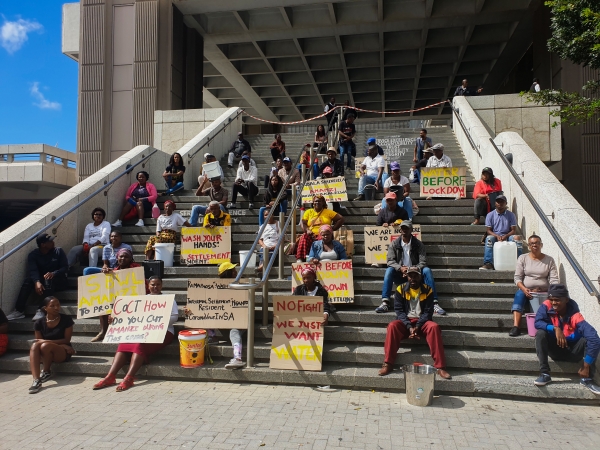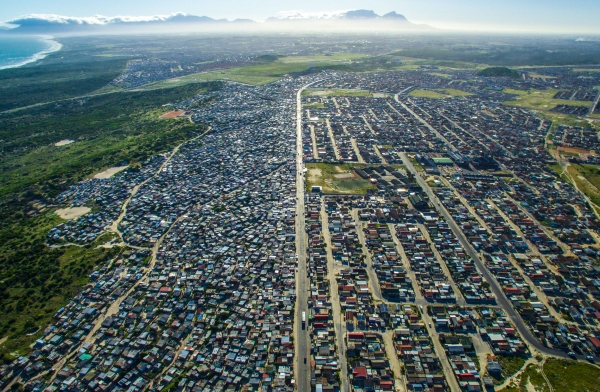Lived realities of urban peripheries: Building infrastructures of change
Apartheid was enacted spatially through infrastructural investment to support institutionalised racism and class inequality. Post-apartheid redress centred on provision of housing, basic services and social grants, but over 26 years later the response has been inadequate. Apartheid’s spectre persists, as millions of South Africans continue to struggle in unsafe and overcrowded conditions. The COVID-19 pandemic has exposed and intensified these conditions. Through ethnographic attentiveness to the everyday struggles of those living on the fringes, research by the University of Cape Town and the HSRC shows the inadequacy of infrastructural access and the lived effects of widespread income and resource insecurity. Suraya Scheba and Andreas Scheba argue that the current crisis offers an opportunity for infrastructural investment and increased public spending in urban peripheries, as part of constructing a new political economy.
For all its devastation, the COVID-19 pandemic is also a moment of opportunity for fundamental change. This is the language President Cyril Ramaphosa has been using in recent public speeches, suggesting an openness to forging a better, fairer and equal society, free from the spectre of a colonial and racist past. Acknowledging that “we cannot merely return our economy to where it was before the virus, but we have to forge a new economy in a new global reality”, he joins a growing number of commentators who propose a radical rethink of the government’s role in promoting socioeconomic transformation.
Ramaphosa has presented public investment in infrastructure as a key driver for change. Comparing the impact of COVID-19 to a post-war situation, he points to the critical role infrastructure can play in bolstering inclusive economic and social development. While we agree with this sentiment, we argue that questions of what, where and for whom are critical to realising meaningful change. As COVID-19 has once again revealed the dire material and economic conditions in our townships and informal settlements, which have been bearing the brunt of South Africa’s pandemic and associated lockdown, we argue that these should be key sites for public investment. Building the material and social infrastructure of urban peripheries holds tremendous potential to correct injustices of the past and drive emancipatory socioeconomic transformation.
Home in the time of COVID-19: An infrastructural lens
Between March and May 2020, we undertook a small study to focus attention on the impact of the pandemic and lockdown on lived experiences in Cape Town’s peripheral neighbourhoods. We used WhatsApp as a platform for discussion with 20 participants from five neighbourhoods: Beacon Valley (Mitchells Plain), Delft, Hillview, Parkwood and Khayelitsha (Harare, Site B). We also organised a Zoom meeting with all participants at the end of May. Households’ living, economic and infrastructural conditions varied across the sites, which influenced the experience.
Inadequacy of basic infrastructure, particularly water and sanitation, exacerbated people’s risk of infection and made practising hygiene and social distancing very difficult. Some beneficiaries of state housing programmes, especially those accommodating backyarders, struggled with the limit imposed by water management devices. Consumption limits also regulated backyarders living on council-owned land, who accessed water via service blocks installed by the City of Cape Town.
Residents in informal settlements relied on communal taps and water tanks. The communal standpipes were sometimes far away, difficult to access or did not work. Long queues meant people spent a lot of time waiting, increasing their risk of infection. To mitigate the burden, the Department of Human Settlements, Water and Sanitation introduced water trucks and tanks, which provided relief.
However, as one respondent from Khayelitsha explained:
“Social distance is really difficult. If the water has run out from the communal taps, you have to run for the tanks/trucks that are coming to assist but, because there are no roads, they can’t stop where you are staying. They stand +-500 m from the house, which makes carrying 20-25 litres difficult.”
For those households with free-flowing water, individual access affordability was a major concern. Increased consumption created anxiety and fear about future water bills and indebtedness.
Beyond water, lockdown also increased the need for, and cost of, electricity. Some were able to benefit from free extra units, but the amount was minimal. Others had to stop using electricity altogether, resorting to paraffin and wood, with adverse health and safety concerns and increased time spent cooking. Lack of electricity also hampered usage of communication technology such as smart phones.
COVID-19 and lockdown aggravated pre-existing social and psychological distress. Many of the participants lamented the lack of space at home, lack of privacy and stress of being in a confined space for so long. As a backyard dweller from Beacon Valley explained:
“… the space is overcrowded and the house is too small. We are in each other’s way. It is very awkward. Just to do the cleaning and washing, we have to not all be in the same room. Everything is too much, we are not used to sit inside cooped up, we are used to go outside to visit family and friends. We are working on each other’s nerves.”
Life outside the house: Overloaded infrastructure
Public and private infrastructure in high-density areas are often overloaded and inadequate to accommodate growing demand. In each neighbourhood the already limited health, social and economic facilities were overwhelmed by the number of people who had to be served under social-distancing measures. The resulting long queues in front of clinics and shops contributed to residents’ risk of contracting the virus. Many participants expressed anxieties and fears around this. A participant from Beacon Valley wrote, “I am afraid that I will be infected while waiting”, which was echoed by a participant from Khayelitsha who said, “Even shopping is risky, there are too long lines and you can get infected. It’s not secure, it’s not safe.”
Limited public transport further exacerbated the situation, as reflected in an account from a participant in Hillview about her trip to the local Shoprite:
“There were no taxis to Shoprite so I used an Uber in Military Road. When returning home, I had to order another Uber because there were no taxis. But robbers robbed the Uber driver while I was standing there.”
As an alternative to supermarkets residents made use of local spaza shops, but complained that “at the spaza shop, there is no adequate food and they are so expensive”.
Conclusions
Investing in physical, social and economic infrastructure in urban peripheries can drive transformative change. This should be supported through mechanisms to redistribute wealth, including a progressive wealth tax and a basic income grant. The case for these measures is increasingly hard to ignore, and they are especially warranted in South Africa, in the context of extreme, racialised wealth inequality.
During the pandemic, we have witnessed shifts in state and community practices that are encouraging. These include the extraordinarily rapid progress in water provision across the country, the increase in state assistance through grants, and the emergence of mutual aid groups that connect people within and across urban neighbourhoods.
These are all prefigurative of what could be but would need to be far more substantive and long term. Currently, we are faced with a choice between intensified immiseration or emancipatory change. We need to choose the latter and construct a society built on a politics of equality as opposed to a politics of austerity and exclusion.
Authors: Dr Suraya Scheba lectures in Environmental and Geographical Sciences at the University of Cape Town, and Dr Andreas Scheba is a research specialist in the HSRC’s Inclusive Economic Development division
suraya.scheba@uct.ac.za
ascheba@hsrc.ac.za

Water protest 2020: In March, at the start of the COVID-19 lockdown, residents from several informal settlements in Khayelitsha gathered on the steps of the Cape Town Civic Centre to demand that they be supplied with water.
Photo: Mary-Anne Gontsana/GroundUp

